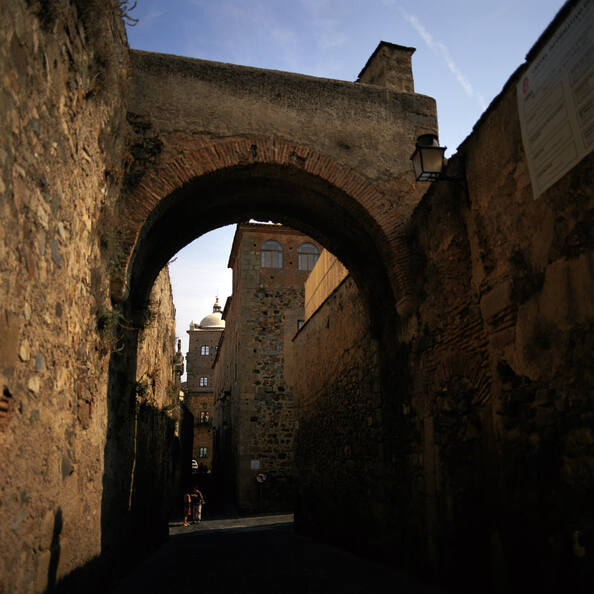Countries<Spain<Extremadura<Cáceres< Ciudad vieja de Cáceres
Declared a World Heritage Site in 1986, Cáceres has an exceptionally well-preserved historic centre of great unity that illustrates the passage of diverse cultures. Its origins can be traced back to Roman, Visigothic, Islamic, Gothic and Renaissance times, including an ancient Jewish quarter in the present-day Barrio de San Antonio. This complex is contained within a walled enclosure of approximately 1,200 m. in length of Almohad origin, often hidden behind buildings from a later period. Quite a few of its Muslim albarran towers (Bujaco, El Horno, Santa Ana, El Postigo, etc.), Christian towers (such as the Púlpitos tower, or the reform carried out on the Bujaco tower) and its entrances (the arch of La Estrella, Santa Ana and El Cristo) have been preserved.
The interior is basically characterised by an irregular layout typical of the medieval period, under which the primitive orthogonal Roman road would have survived. The result is a group of small streets and small squares, among which the Calle Ancha, the Cuesta de Aldana, the Calle Pereros and the corner of the Monja or the squares of Santa María and San Mateo stand out for their beauty. In these spaces are the beautiful façades of civil and religious buildings, such as the Palace of the Golfines de Abajo, the Casa de las Veletas, the Casa del Sol, the Casa Mudéjar or the Torre de los Plata.
The origins of the city date back to the 1st century B.C. when the Romans settled on this quartzite plateau and founded Norba Caesarina. There is clear evidence of this colony, of the subsequent occupation of the area in the Visigothic period and of more recent urban phases in the archaeological area located in the courtyard of the Mayoralgo Palace. The city would not regain its strategic importance until the Moorish occupation. The Almohads reorganised the primitive walled city of Roman origin in order to halt the Christian advance. After the Reconquest and repopulation, the city experienced a period of splendour during which numerous palaces, churches and convents were built. Between the 14th and 15th centuries, the city was dominated by the confrontation between powerful enemy factions, which gave rise to the construction of some of the numerous fortified houses, palaces and towers with a renewed building boom from the 16th century onwards. These buildings bring together the most diverse architectural influences and styles, from Islamic to Northern European Gothic and Italian Renaissance. All this coexists in an unusually harmonious whole, making Cáceres an extraordinary example of the confluence of very diverse cultures.
Declarada Patrimonio Mundial en 1986, Cáceres posee un centro histórico de gran unidad excepcionalmente bien conservado que ilustra el paso de diversas culturas. Sus orígenes pueden rastrearse hasta la época romana, visigoda, islámica, gótica y renacentista, incluyendo una judería antigua en el actual Barrio de San Antonio. Este conjunto está comprendido dentro de un recinto amurallado de aproximadamente 1200 m. de longitud de origen almohade, a menudo oculto tras edificaciones de época posterior. Se conservan bastantes de sus torres albarranas musulmanas (la de Bujaco, la del Horno, la de Santa Ana, la del Postigo,...), cristianas (como la de Púlpitos, o la reforma realizada en la torre de Bujaco) y de sus accesos (el arco de la Estrella, de Santa Ana y del Cristo).
El interior se caracteriza básicamente por un trazado irregular típico de la época medieval, bajo el que perviviría el primitivo viario ortogonal romano. El resultado es un conjunto de pequeñas calles y plazuelas, entre las que destacan, por su belleza la Calle Ancha, la Cuesta de Aldana, la Calle Pereros y el rincón de la Monja o las plazas de Santa María y de San Mateo. En estos espacios se levantan las bellas fachadas de edificios civiles y religiosos, como el del Palacio de los Golfines de Abajo, la Casa de las Veletas, la Casa del Sol, la Casa Mudéjar o la Torre de los Plata.
El origen de la ciudad se remonta al siglo I a.C. cuando los romanos se asentaron sobre esta meseta cuarcítica y fundan Norba Caesarina. De dicha colonia, de las posteriores ocupaciones del espacio en época visigoda y de fases urbanísticas más recientes, tenemos claros testimonios en el área arqueológica situada en el patio del Palacio de Mayoralgo. La ciudad no volvería a recuperar su importancia estratégica hasta la ocupación árabe. Los almohades reorganizaron el primitivo amurallado de origen romano, para frenar el avance cristiano. Tras la Reconquista y Repoblación, la ciudad conoció un periodo de esplendor durante el cual se construyeron numerosos palacios, iglesias y conventos. Entre los siglos XIV y XV, la ciudad estuvo dominada por el enfrentamiento entre potentes facciones enemigas, lo que dio origen a la construcción de una parte de las numerosas casas fortificadas, palacios y torres con un renacido auge edificatorio a partir del siglo XVI. Dichas edificaciones reúnen las más diversas influencias y estilos arquitectónicos, desde el islámico hasta el gótico del norte de Europa y el Renacimiento italiano. Todo ello convive en un conjunto de inusual armonía, lo que convierte a Cáceres en un ejemplo extraordinario de confluencia de muy diversas culturas.
